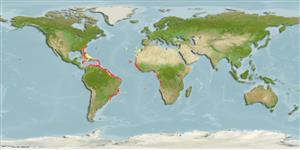Common names from other countries
Classification / Names / Names
Populärnamn | synonymer | Catalog of Fishes (gen., sp.) | ITIS | CoL | WoRMS
Environment: milieu / climate zone / depth range / distribution range
Ekologi
Bentopelagisk; brackvatten; djupintervall 1 - 421 m (Ref. 105052). Tropical; 35°N - 31°S, 82°W - 14°E
Atlantic Ocean: from southeastern Florida to Brazil rarely in Bermuda and North Carolina, also in the Cape Verde Islands and along the African coast from Mauritania to Angola.
Length at first maturity / Size / Vikt / Age
Maturity: Lm ? range ? - ? cm Max length : 10.0 cm CW hane/ej könsbestämd; (Ref. 417)
In shallow littoral environments, typically from intertidal pools to 3 m (Ref. 105199). Inhabits shallow salt water on sandy or sandy mud bottom (Ref. 435) in brackish waters of estuaries (Ref. 417). Also found on algae and grass flats, sandy beaches, rocky pools, eroded coral bases (Ref. 105199), coral reef (Ref. 121879), oyster bars (Ref. 105199), and edge of mangroves (Refs. 105199, 121880). Rarely found in the open sea, from the intertidal to depth of 25 m (Ref. 121880). Associated with the barnacle Chelonibia sp. (Ref. 105200). In general, portunids are opportunistic omnivores with preference for animal prey (Ref. 100840).
Life cycle and mating behavior
Könsmognad | Reproduktion | Lek | Ägg | Fecundity | Larver
Members of the order Decapoda are mostly gonochoric. Mating behavior: Precopulatory courtship ritual is common (through olfactory and tactile cues); usually indirect sperm transfer.
Fischer, W., G. Bianchi and W.B. Scott (eds.). 1981. (Ref. 435)
IUCN Red List Status (Ref. 130435)
CITES status (Ref. 108899)
Not Evaluated
Not Evaluated
Human uses
Fiskeri: kommersiell
| FishSource |
Verktyg
Internet-källor
Estimates based on models
Preferred temperature
(Ref.
115969): 14.1 - 24.4, mean 17.5 (based on 89 cells).
Vulnerability
Low vulnerability (10 of 100).
